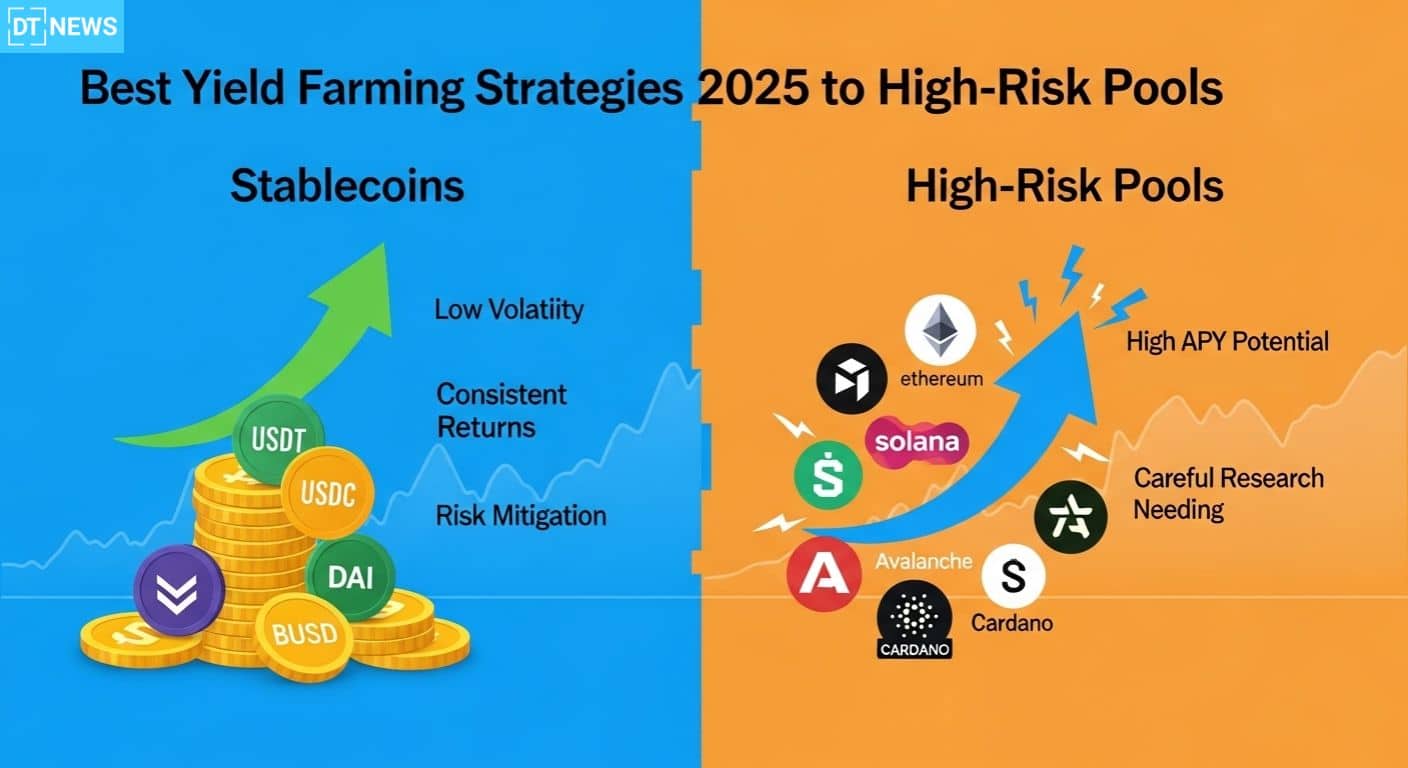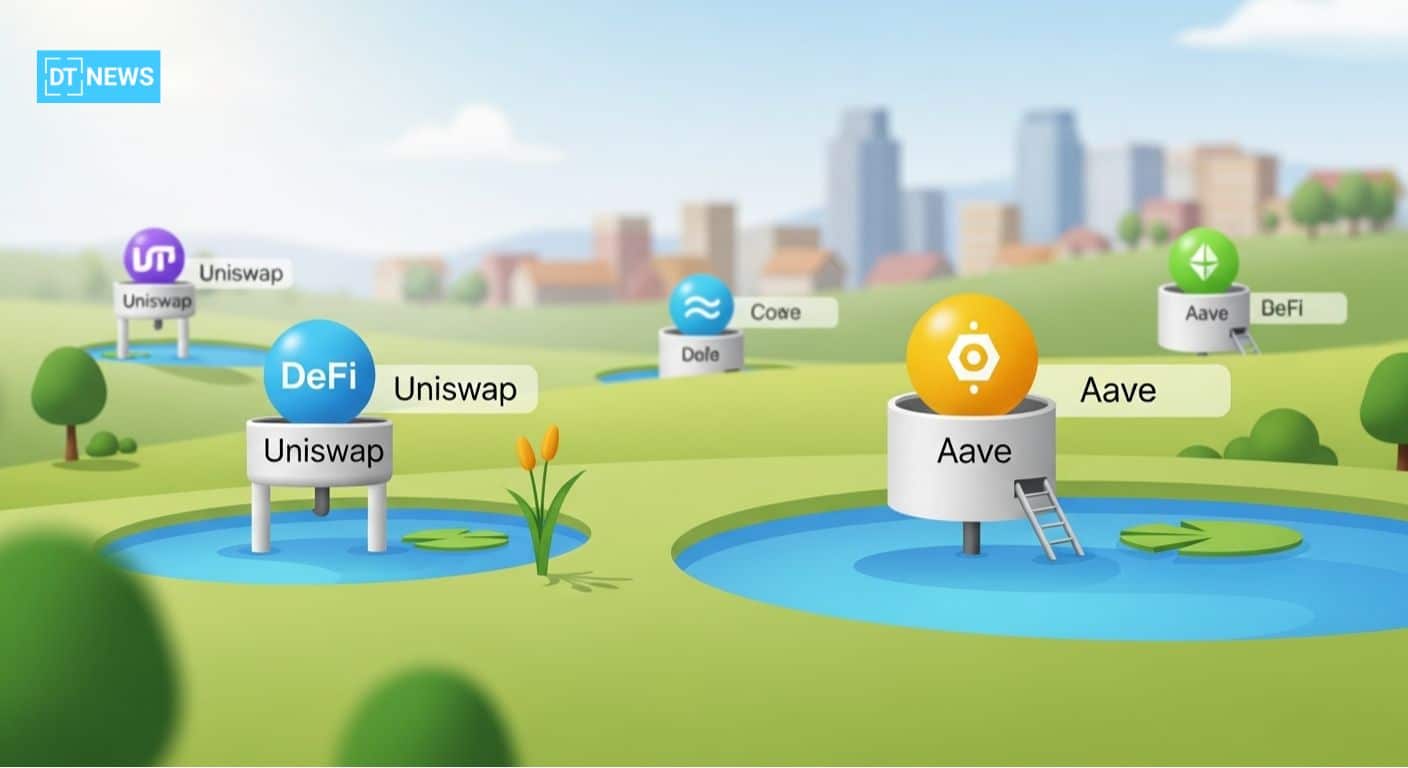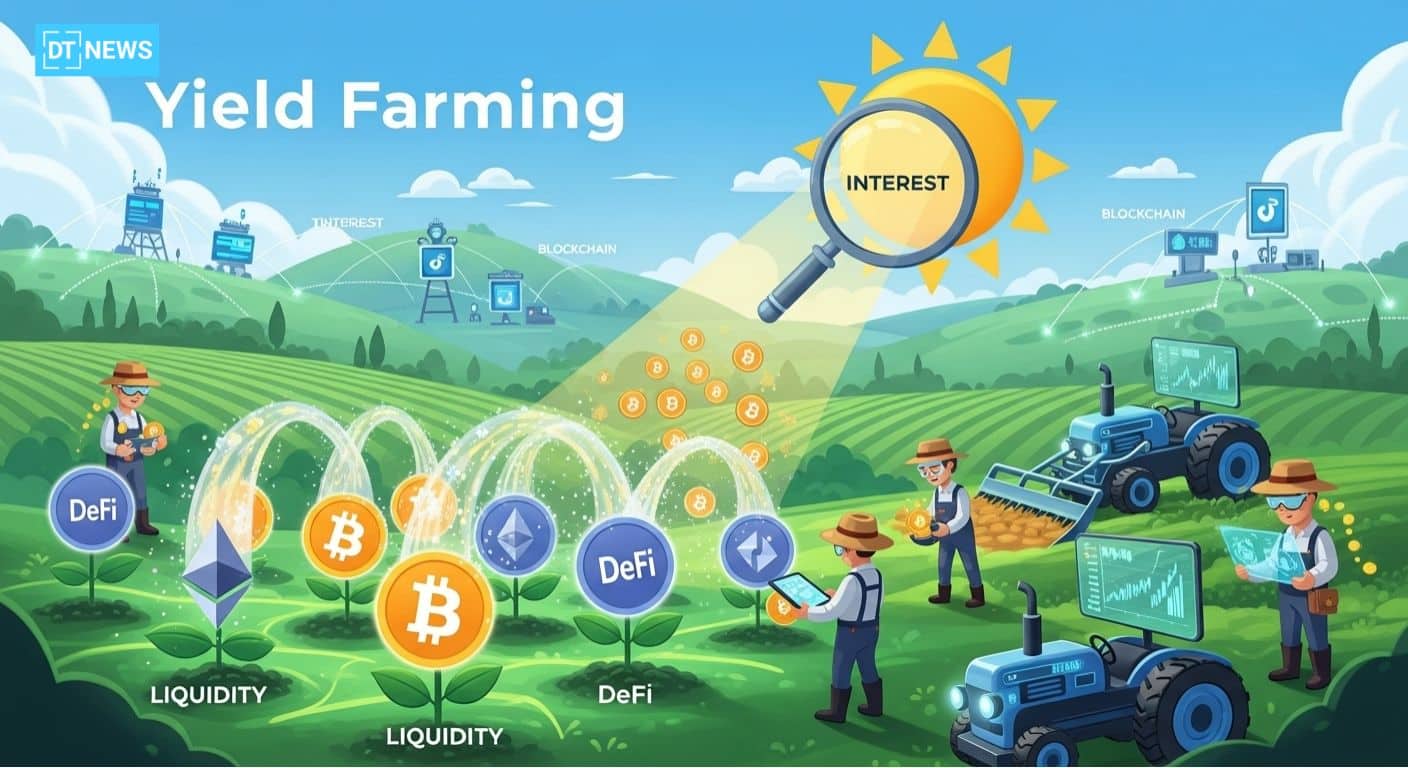This article was first published on Deythere.
- Stablecoin Yield Farming: Low-Risk Foundations
- Diversified and Balanced Pools
- Innovative Fixed-Rate and Tokenization
- Restaking and Liquid Staking Strategies
- High-Risk Pools and Opportunities
- Expert Analysis: Managing Risk and Reward Like a Pro
- Conclusion
- Glossary
- Frequently Asked Questions About Yield Farming Strategies 2025
Yield farming strategies in 2025 range from safe, secure stablecoin lending to risky, high-APY pools. Stablecoins like USDC, USDT, and DAI are still building blocks. Platforms offer about 5-12% APY on stablecoin deposits. Leading lending services market up to 16% on USDT/USDC, while protocols like Aave and Curve offer mid-single-digit yields through actual demand.
In the meantime, new DeFi ideas such as tokenized yield (Pendle), liquid restaking (EigenLayer) and dynamic AMMs (Maverick) can increase returns too.
The other side of this, are pools with exotic tokens where triple-digit APYs are advertised, but experts warn that “the math whispers warnings”, impermanent loss and fees frequently eat away all or most of the gains promised.
Stablecoin Yield Farming: Low-Risk Foundations
Stablecoins are USD-backed crypto assets, and farming them often has less risk. In 2025, stablecoin lending (both CeFi and DeFi) dominates the safe end of yield farming strategies. Leading centralized platforms (Nexo, Binance, Crypto. com, etc) promote 6-16% APY on USDC/USDT with no lock ups.
As an example, Nexo pays 16% on USDT (with token holding conditions), as well as 14% on USDC. Decentralized lending is similarly attractive. Aave V3 and Compound often pay 2-8% APY on stablecoin deposits (variable rates, depending how much people want to borrow).
In fact, one estimate places Aave V3 as “highest safety” with 4.67% APY (USDC) due to its massive TVL and security history.
Another important approach are DEX pools for stablecoins, like Curve Finance. Curve pools (the USDC/USDT/DAI 3pool for example) are designed to be used for trading between like-valued assets with minimal slippage. By design, impermanent loss is minimal in stable pools.
Curve’s base fees only generate a few percentage points of APY from trades, but vote-locked incentives can lift returns. For instance, Curve’s $2.73billion stablecoin TVL yields 5 – 20% APY when users lock CRV tokens in order to boost yield for them. In reality, many conservative stablecoin farmers earn single-digit returns, but external rewards (gauges, tokens) can boost APYs temporarily.

| Strategy | Examples | Typical APY (2025) | Risk & Notes |
| CeFi Stablecoin Lending | Nexo, Crypto.com, Binance | 6-16% APY | Centralized counterparty risk; some require lockups/tokens. |
| DeFi Stablecoin Lending | Aave, Compound, Morpho | 2-8% APY (variable) | Smart contract risk; audited protocols. Risk of liquidation if collateral falls. |
| Stablecoin AMM Pools | Curve Finance, Balancer | 0-5% base (boosted to 10-15%) | Minimal IL (similar assets); yields from fees and incentives. |
| Fixed-Rate Token Yields | Pendle (sUSDe, etc.) | 10-15% APY fixed | Complex derivatives; audited but newer. Locks funds to guarantee rates. |
| Yield Aggregators | Yearn, Beefy | Varies (compounds above) | Auto-compound underlying positions; adds contract risk. |
| Liquid Staking (ETH) | Lido (stETH), RocketPool | 4-5% APR + fees | Staking risk: downtime/slashing, but liquid tokens tradeable. |
| Liquid Restaking (ETH) | EigenLayer, Ether.fi | 5-10% extra | New tech; adds smart-contract and concentration risk. |
| Dynamic AMM (LP Automation) | Maverick Protocol | +20-30% returns | Moves LP position for users; mitigates IL; complex mechanism. |
| High-Risk DeFi Pools | Volatile token LPs | 50-100%+ APY | Huge IL and smart-contract risk; unsustainable long-term. |
Stable methods trade off lower APY for security. As TransFi concludes, DeFI protocols such as Aave and Curve operate from 5%-12%”APY with stablecoins during normal market conditions while only “advanced tools like Ethena and Morpho Blue are driving returns closer to 20%-30%”.
Most retail yield farmers go with Aave/Curve and centralized lenders. For example, in Curve’s pools, conservative yield farmers might be picking up 0-5% APY on the pool but pegging some extra CRV could increase net returns to 10-15%.
However, regulation is moulding stablecoin yields. The US’ GENIUS Act would, in particular, prohibit stablecoins from paying interest. Adoption of this law will require that U.S. institutions to avoid offshore yield strategies on USDC/USDT.
Thus, a likely outcome for U.S. users is a shift from an on-chain stable yield to another asset, or moving to offshore DeFi platforms. Regardless, global users will need to keep a close eye on how compliance shapes up as it may snip some 5-10% APY-earning options for stablecoins.
Diversified and Balanced Pools
Though pure stablecoin farming has the lowest-risk, moderate strategies include blue-chip tokens within stable assets. These target higher yield without going all the way into high-risk territory. Hybrid pools such as Etherfi Cash let users to deposit USDC into a market-neutral vault earning somewhere around 9-10% APY.
Another is a Balancer pool with AAVE’s stablecoin GO paired with USDC on Base chain (via Beefy) which gives 12-17% APY with nearly stable tokens. These approaches automatically compound gains and take minimal effort once they are established, falling in between for steady returns.
Blue-chip LP pools are also viable. Adding ETH to a stablecoin pair on DEXes like Uniswap or SushiSwap can earn trading fees (usually 3-10%) plus occasional farming rewards. However, this makes the users susceptible to impermanent loss if ETH makes a sudden move.
Even top LPs like Aave’s lending pool only pay 4-7% APY on stable LPs, meaning it could be less than simpler stable strategies. But one can also earn similar yields while diversified away from 100% stablecoins by providing liquidity to pools of major tokens (e.g. ETH/USDC).
Diversifying yield also involves employing aggregator protocols. Platforms like Yearn or Beefy will automate the movement of assets between top farming pools. These can raise yields slightly by taking short-term incentives, but they cannot sustain crops.
For instance, Maverick Protocol’s dynamic AMM changes liquidity to follow price movements automatically on Uniswap V3 producing an alleged 20-30% increase in returns compared with static positions. These tools work for hands-off farmers who want extra yield and don’t care to manually rebalance.
Innovative Fixed-Rate and Tokenization
New DeFi innovations allow farmers to lock in fixed yields or trade future yields. The most prominent of these is Pendle Finance which tokenizes future yield streams. The sUSDe pool of Pendle offers like 13-14% fixed APY for Q3 2025; and allows users to lock the rates far ahead.
Ethena’s stablecoin protocol has pools, too, where users can earn double-digit yields by minting and staking its USDe token. Such fixed-rate arrangements can beat floating rates, but they are more complicated and have smart-contract risk.
Other implementations involve RWA (Real-World Asset) techniques. Platforms even started tokenizing short-term Treasury yields into crypto assets, which allowed stablecoins to earn close-to-government rates plus a little more.
While offers on CeFi were at 6-8%, these DeFi hybrids could nudge yield a few points higher with moderate risk.
In brief, fixed-income DeFi protocols aim for safely earning returns in the 10-20% range but demand some skill to use.
As one review states, “Stablecoin yield farming in 2025 is smarter and more automated than it used to be” but advanced tools such as Pendle or Morpho Blue also require careful risk management.
Restaking and Liquid Staking Strategies
Another area of growth has been staking-based farming. Classic staking in ETH is yields about 4-5%, however liquid staking platforms (Lido, RocketPool) end up issuing a tradable token (stETH, rETH) for liquidity.
In 2025, a new layer has emerged which is restaking. Protocols like EigenLayer allow validators (and even retail via proxies like Ether.fi) to re-use staked ETH to secure new networks or services, earning extra rewards.
EigenLayer has explosive adoption. TVL quickly grew from $1.1B to more than $18B by mid-2025. Users are essentially double-dipping, meaning they still keep the base staking yield (4-5%) and layered yield from “Actively Validated Services” (oracles, dA layers, etc).
An estimated $17.5B worth of ETH has already been restaked, a growing testament to how common this strategy is now. Liquidity providers such as Kraken (via Staked) integrated EigenLayer for its ease of integration, thereby enabling staking to restake users’ deposited ETH.
In real terms, restaking can compound another 5-10% APY on top of the base ETH stake (rates vary by service). For example, Ether. fi’s ETH vault yields roughly the sum of Lido’s staking (4%) plus restaking APR. The capital efficiency is off the charts: one QuickNode report describes restaking as “a financial tectonic shift” that enables staked ETH to work “infinitely harder”.
That said, restaking is new and introduces its own risks. Farmers should consider the liquid restaking yields somewhat experimental. Yet, for the technically competent who are comfortable staking, these strategies can end up being a significant bump in returns on a solo collateral of just ETH.

High-Risk Pools and Opportunities
On the other end are high-risk, high-reward pools. These range from small-cap token pairs, to meme coin farms, cross-chain bridges and new DeFi innovations. These APYs here may be in excess of 50-100%, however, with a significantly high risk.
Common downfalls are significant impermanent loss, or a lack of liquidity, and even smart-contract bugs. Early-farmer tales and DeFi summer favorites served as reminders that 10,000% APY pools will fall apart without sustainable economics.
Experts urge caution. Nic Roberts-Huntley of Blueprint Finance says, these eye-popping APYs often obscure “impermanent loss, gas fees and liquidity constraints” that can offset those gains.
In other words, the advertised yield may scream opportunity but the math typically whispers warnings. Retail investors, who do not have sophisticated risk models, may be stuck being on the wrong side once rewards fizzle.
Be that as it may, some traders are still putting a fraction of their capital in dynamic pools. Some strategies are: concentrated liquidity on Uniswap V3 to earn higher fees, leveraged farming with Vaults or a speculative entry liquidity into trending assets.
Handled correctly, these can sometimes beat steady yields. As a rule, one should only ever put risk capital into the these. A more refined approach for reducing risk is to use established protocols (>1B TVL) and stick to pools with established tokens, even though it doesn’t eliminate the risk.
Expert Analysis: Managing Risk and Reward Like a Pro
The fluid to optimal yield farming in 2025 is balancing risk vs. reward. Contemporary tactics reward discipline over chase. And, as one guide counsels: “If the APY appears too good to be true, it probably is.”
Successful farmers should factor in after cost return. Factor in impermanent loss, gas fees and reward token volatility. Many advertised APYs are actually high because they involve token emissions that decrease over time.
Divide money among strategies, a combination of fixed yields and small high-risk bets. This balances portfolio risk. For example, one can opt for 70% in safe pools (Aave/Curve etc.) while the remaining is invested in riskier farms with higher yield.
Never put more than 10% or some small percentage of one’s portfolio into any one high-risk farm. Large farms can still fail.
Yield farming 2025 is evolving fast. New protocols like dynamic AMMs and fixed-yield tokens emerge frequently. Check reviews and reputations before placing funds.
Institutional tactics already embody this. Figment’s 15% stable yield product (staking SOL via futures,) is a great example when professional teams bundle up yield with risk controls.
Retail farmers have to be more cautious. According to sources, taking the biggest APY number without question is the anchor bias that can cost retail investors dearly”.
Protocol TVL (total value locked) and audit history matter. Aave, Curve and Uniswap protocols have been subject to market cycles and security incidents, making them relatively “battle-tested”. These newer ones like Pendle, Maverick, and Restaking services) show promise but should be approached after thorough due diligence.
Conclusion
Yield farming strategies in 2025 include a mix of low-risk stablecoin tactics and targeted high-reward plays. Stablecoin strategies like lending on Aave, curve pools, CeFi platforms generate steadily 5-12% APY.
Innovations such as yield tokenization and liquid restaking can supplement returns even more. There are also very high-yield pools but they come with enormous risks, and experts warn that after impermanent loss and hidden fees, any advertised gains can be illusory.
The best strategies in 2025 will tend to be those that are denominated and dominated by stablecoins and rigs with good fundamentals, but layered soundly with higher-yielding instruments as skill and risk-appetite permit.
Always calculate net returns and diversify. By sensibly balancing these strategies, crypto investors can pocket significant DeFi yields without exposure to huge risks.
Glossary
Yield Farming: A DeFi strategy with which users stake, lend or provide liquidity to a decentralized protocol in order to earn some sort of interest, fees or the protocol’s native token.
Stablecoin: A collateralized crytocurrency to fiat (eg USD) value. Popular examples: USDC, USDT, DAI. Frequently offered in yield farming for guaranteed fixed returns.
APY (Annual Percentage Yield): The return on an investment each year, taking into account the effects of compounding. Indicates how much one can earn in a year.
Liquidity Pool : A smart-contract escrow holding a pair of tokens (eg: ETH/USDC) that allows traders to swap between assets. Fees from trading are shared with providers.
Impermanent Loss: The loss that LPs experience when tokens diverge in price from the ratio at which they deposited. If prices move too far, it can erase farming gains.
Restaking: Re-using previously staked assets (e.g. ETH staked to secure PoS) and using this to secure further DeFi services (e.g. EigenLayer) yielding multiple products from a single stake of capital.
APR vs. APY: APR is the simple annualized interest rate; APY takes the impact of compounding into account. In DeFi, APY is often used to communicate overall earned yield over the course of one year.
Frequently Asked Questions About Yield Farming Strategies 2025
What is yield farming in crypto?
Yield farming is depositing crypto assets (like stablecoins and tokens) into DeFi protocols in return for rewards back to the holder, including interest, fees, or additional tokens.
What are the most effective approaches in 2025?
The best prospects often involve complex or risky plays. Simple stablecoin lending yields 5-12% APY on Aave while advanced strategies like fixed-rate pools or liquid restaking can push into the tens. The higher the APY (about 20-50%+), the riskier the pools tend to be. A balanced approach using Curve or Aave for baseline yield, plus a small number of bets on token incentives, is often recommended.
Is yield farming with stablecoins safe?
Farming stablecoins is one of the safer DeFi strategies, yet still risky. Platform risk and bugs in smart contracts are still present. Experts recommend following audited protocols and allocating no more than a small percentage of an overall portfolio to any single position. Also, regulatory risks like new laws (e.g. US GENIUS Act) could make it illegal to earn interest on stablecoins, impacting future yields of such assets.
What can one do to reduce the risk when yield farming?
Diversification and research are key. Leverage large, tried-and-tested protocols to prevent an audit failure. Where possible, stick to pools with more than $1B TVL. Determine expected returns after fees and impermanent loss. Don’t hold more than a small percentage (like 10%) of your portfolio in any high-yield farm



















































































































